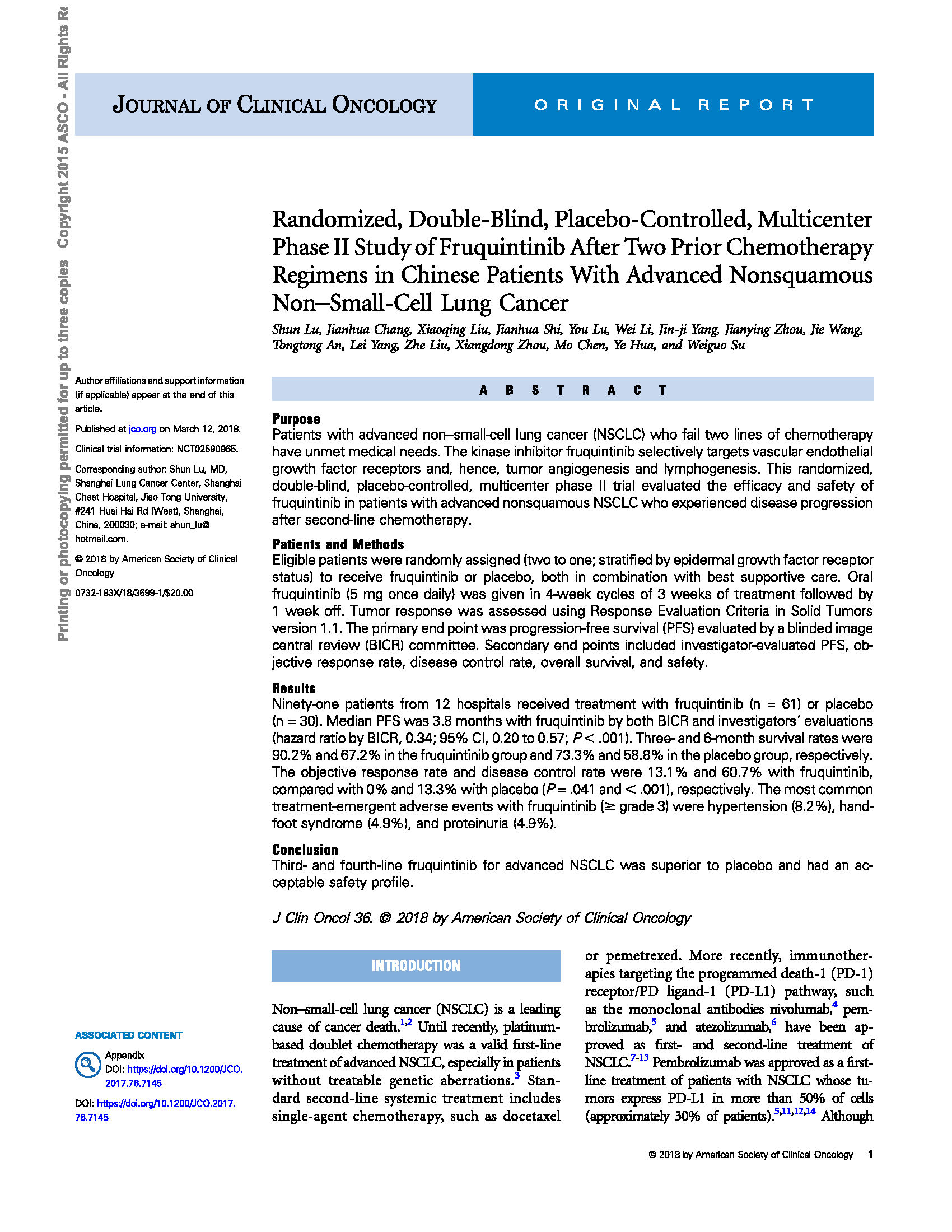- Chi-Med
- News & Presentations
- | Presentations
Journal of Clinical Oncology: Phase II Trial of Fruquintinib in Patients with Advanced Nonsquamous NSCLC
 Shun Lu, Jianhua Chang, Xiaoqing Liu, Jianhua Shi, You Lu, Wei Li, Jin-ji Yang, Jianying Zhou, Jie Wang, Tongtong An, Lei Yang, Zhe Liu, Xiangdong Zhou, Mo Chen, Ye Hua and Weiguo Su
Shun Lu, Jianhua Chang, Xiaoqing Liu, Jianhua Shi, You Lu, Wei Li, Jin-ji Yang, Jianying Zhou, Jie Wang, Tongtong An, Lei Yang, Zhe Liu, Xiangdong Zhou, Mo Chen, Ye Hua and Weiguo Su
Abstract
Purpose
Patients with advanced non‒small-cell lung cancer (NSCLC) who fail two lines of chemotherapy have unmet medical needs. The kinase inhibitor fruquintinib selectively targets vascular endothelial growth factor receptors and, hence, tumor angiogenesis and lymphogenesis. This randomized, double-blind, placebo-controlled, multicenter phase II trial evaluated the efficacy and safety of fruquintinib in patients with advanced nonsquamous NSCLC who experienced disease progression after second-line chemotherapy.
Patients and Methods
Eligible patients were randomly assigned (two to one; stratified by epidermal growth factor receptor status) to receive fruquintinib or placebo, both in combination with best supportive care. Oral fruquintinib (5 mg once daily) was given in 4-week cycles of 3 weeks of treatment followed by 1 week off. Tumor response was assessed using Response Evaluation Criteria in Solid Tumors version 1.1. The primary end point was progression-free survival (PFS) evaluated by a blinded image central review (BICR) committee. Secondary end points included investigator-evaluated PFS, objective response rate, disease control rate, overall survival, and safety.
Results
Ninety-one patients from 12 hospitals received treatment with fruquintinib (n = 61) or placebo (n = 30). Median PFS was 3.8 months with fruquintinib by both BICR and investigators’ evaluations (hazard ratio by BICR, 0.34; 95% CI, 0.20 to 0.57; P < .001). Three- and 6-month survival rates were 90.2% and 67.2% in the fruquintinib group and 73.3% and 58.8% in the placebo group, respectively. The objective response rate and disease control rate were 13.1% and 60.7% with fruquintinib, compared with 0% and 13.3% with placebo (P = .041 and < .001), respectively. The most common treatment-emergent adverse events with fruquintinib (≥ grade 3) were hypertension (8.2%), hand-foot syndrome (4.9%), and proteinuria (4.9%).
Conclusion
Third- and fourth-line fruquintinib for advanced NSCLC was superior to placebo and had an acceptable safety profile.
Citations and Links
Please follow the DOI link to access the publication:
J Clin Oncol.2018 Mar 12:JCO2017767145
DOI link: 10.1200/JCO.2017.76.7145
PubMed unique Identifier link: 29528793